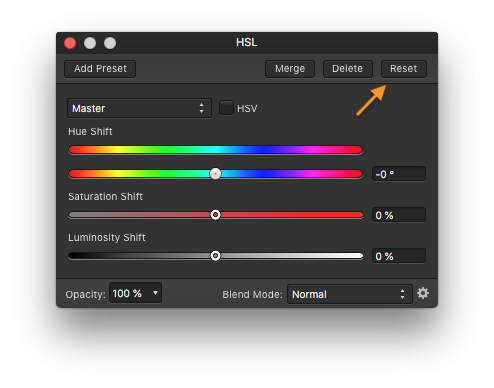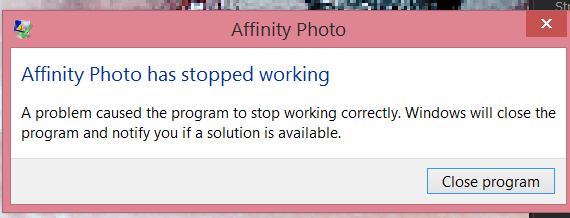
ncJohn
-
Posts
166 -
Joined
-
Last visited
Posts posted by ncJohn
-
-
-
53 minutes ago, hannah said:
Did you see, right next to the sliders there is an input field. You can type in "0" and then hit the enter-key. Does that help you?
No, it's not really faster than just fiddling with the slider. In general, I use the keyboard very little, never use keyboard shortcuts, because it means taking your eyes off the screen and your hand off the mouse. I'm a "mouse person."
 But thanks.
But thanks.
-
The best way to explain what I want to know is to use an example. So let's say the saturation slider in the HSL palette. When I've moved the slider off of 0 and I want to return it to 0, is there a way to make the slider jump to 0 instead of fussing back and forth, under-shooting and over-shooting with it until it finally settles at 0? In other programs you can, for example, double-click on the slider, or double-click on the word "saturation" or some such, and the slider just jumps to 0.
-
-
-
That's some pretty good sleuthing, but I think it's more complicated than that. Right now I still get a single circle at 2000 and 100%, and at 3000 I get concentric circles even with the hardness as low as about 35. And earlier today, when I left the message, I really think I was getting concentric circles at around 1200. I'm not absolutely sure of that, but I know I wasn't using a brush size of 2000, and I have to go larger than that right now to get the concentric circles.
...
Ah-ha! It depends on the brush! Using an "effects" brush, as I was doing earlier today, I do get concentric circles around 1200. But I still don't know what it means and how to use it. I understand your conclusion that it's a warning that the brush is too big, but it sure doesn't kick in soon enough; at 2000 that single circle is larger than my monitor screen.
I'm looking forward to getting an official explanation.
-
Some of the brushes (paintbrush, smudge, blur), if you enlarge the pixel width enough, are represented by concentric circles instead of just a single circle.
Why is that?
-
Okay, thanks. I'll give that a try.
-
I have an image that I've altered using 4 adjustment layers. I've grouped those layers into a group that I want to save so that I can apply the same group to other images. The only way I can find to do it is to save the group as part of the image so that in the future, when I want to use the group, I can open the image containing the group, copy it, and paste it onto the new image.
I know there's probably a way to do it but I don't know what it is. Am I talking about a preset, a style, or what? How do I save this group of adjustment layers?
Thanks
-
So it seems that there are a lot of factors in whether or not this "file has been modified" notification shows up. But if I understand correctly, as long as the only thing I've done since saving the file is to export it, then the file really hasn't been changed at all and it really doesn't matter whether I answer "yes" or "no" to the question.
-
It doesn't seem to matter whether or not "save history" is turned on.
-
1 minute ago, walt.farrell said:
I think that any changes to the history count as a modification, and thus cause that prompt.
I have noticed something like this this with another program, where I could open a file, print it, and discovered that the act of specifying the print options counted as a modification.
Adobe Illustrator CS does that when printing.
If AP is using the history as an indicator that the image has changed, I suppose that would be an easy way to do it but that one extra wasted mouse click, over many images, is quite a nuisance.
-
1 minute ago, v_kyr said:
I can't reproduce this behavior under OSX. After saving an altered document as an .afphoto file and then afterwards exporting it as a JPG will here not mark/flag the file as being dirty again. I can close the file as normally expected. - Are you using a APh Mac or Win version?
Windows 8.1.
-
Well, the only history entry is "apply the export options preset" which is something along the lines of "TIFF RGB 16-bit." But I would think that would apply only to the exported TIFF, not the image that stays behind.
-
When working with an image, if you export it then close the image, before it closes a little "close document" window comes up that says, "image xxx has been modified. The document is about to close, would you like to save your changes?"
How does exporting it modify it?
Just to be clear, the chain of events is: edit or create image, save it as afphoto, export it as jpg or tiff, then close. So what changes after the "save"?
-
It was an afphoto file, so just an image file, with a pixel layer taken into the plug-in.
This crash report is from January 1, it's the most recent one that was there; I don't remember when the crashing started.
Now, I've played with it some more and found this: I had a file opened in NIK for almost an hour and it didn't crash. I didn't play with it, I just moved some sliders briefly and then left it. I went back later and did it again. Finally I saved it back to AP and everything was fine. But when the crashes happened, I was experimenting, moving sliders around to see what effects different settings cause, back and forth, back and forth, change, change, change. (I look for effects, not necessarily realism, in my work.) It's in the middle of doing this that the crashes happen. It's kind of like maybe NIK or AP buffers all the changes until the file is saved, and some buffer filled up and then boom! What do you think of that idea?
-
-
AP has started crashing when I use either of the sharpening tools in the NIK collection. If I just go there, make an adjustment and then come back quickly, it's fine. But if I play with the sliders for a couple minutes, AP crashes. (There's a Windows message that says AP has stopped working.) I first noticed it a couple days ago and it happens every time if I give it just a minute or so. I use several of the NIK tools regularly and this only happens with the sharpeners.
I'm using Windows 8.1 and AP 1.6.1.93. Is this a known problem? (I couldn't find any posts about it, but I also couldn't find any on the NeatImage crashes until I asked here and someone responded.)
-
-
Is there an "official" explanation of "New View" and "Views" under the top View menu? I can kind of see what they're about just by playing with them but I wonder if there are nuances I haven't found. I found the help video about View Points but nothing about View>Views.
-
I'm using the latest versions of AP (1.6.1.93) and Neat Image plug-in (8.3.1.0). They used to work fine together, but both have recently been updated, and I don't know whether I've used the Neat Image plug-in since the updates. AP takes an exception and crashes after the plug-in call regardless whether I'm working on .tif, .psd, or .afphoto files. Other plug-ins seem to be fine (NIK collection and PortraitPro). A week or so ago, after a crash, the Crash Reporter window came up and I filled in the info but haven't heard anything about it.
I expected to see some posts here about it but don't find anything; am I the only one?
I'm using Windows 8.1 64-bit and the 64-bit version of Neat Image.
-
1 minute ago, Callum said:
Hi ncJohn,
If you click the thumbnail of the mask then hit the delete key or right click the mask thumbnail and click delete you should find it only deletes the mask

C
Ah-ha! I tried right-clicking the whole layer but not just the thumbnail.
Thanks a lot.
-
Adding a mask layer to a pixel layer is easy, but how do you delete the mask if you decide you don't want it? When I select a mask layer it always also selects the pixel layer it's attached to.
Thanks
-
40 minutes ago, carl123 said:
If you cant get the Selection Brush to work for you then try zooming in and using the Free hand Selection Tool
Yeah, I tried that but it still comes down to personal judgement about where the line is between "red and not red." I wasn't happy with where I was putting it so I tried to let the program decide for me. Wasn't exactly the perfect decision.





Is there a "jump to zero" for sliders?
in Pre-V2 Archive of Affinity on Desktop Questions (macOS and Windows)
Posted
Well, that's not great, but it's something I didn't know about. Thanks.